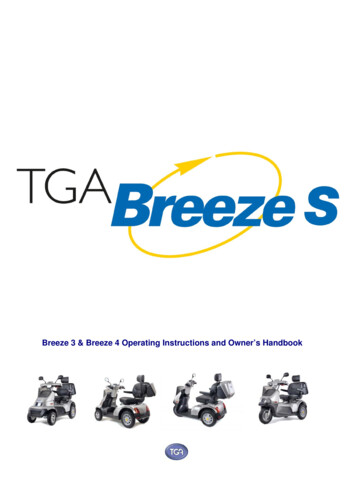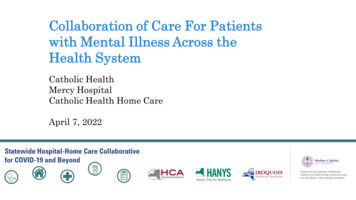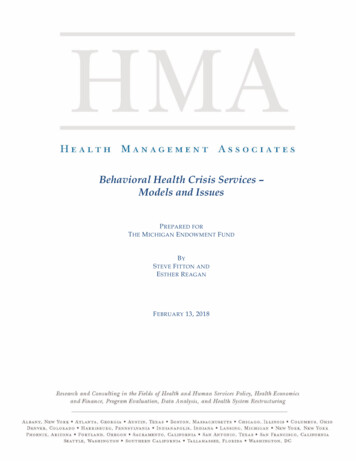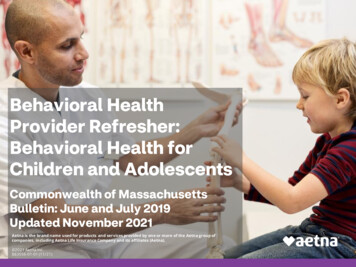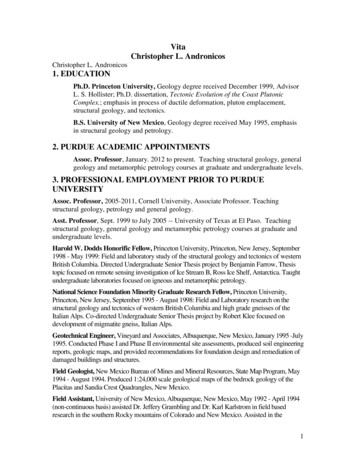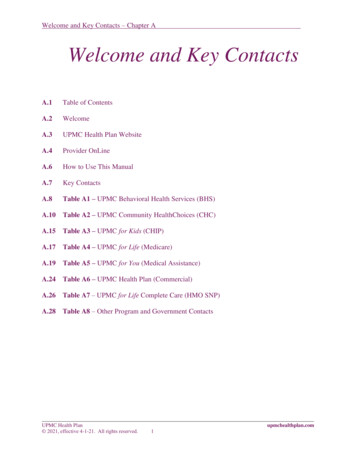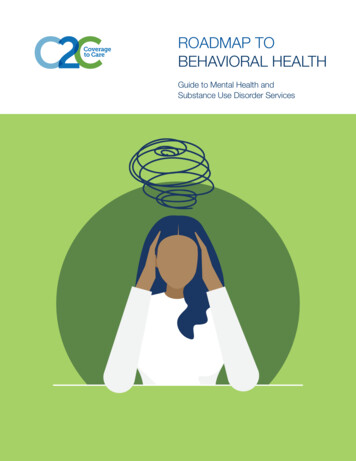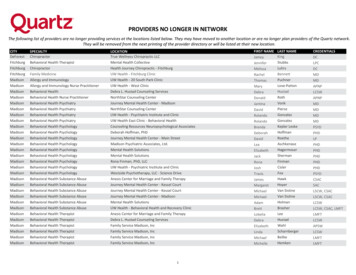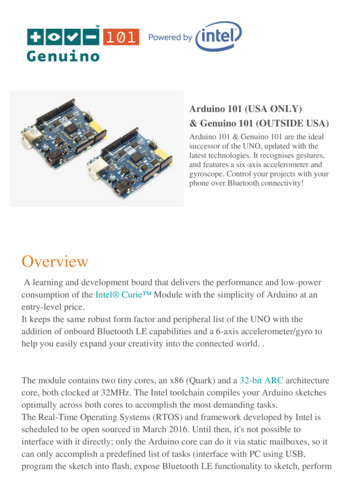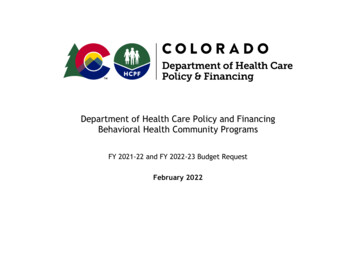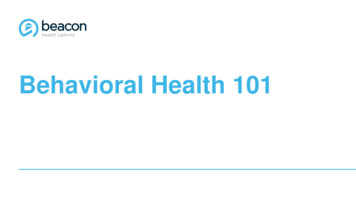
Transcription
Behavioral Health 1011 Copyright Beacon Health Options, Inc. 2020No part of this training may be reproduced, distributed or transmitted in any form or by any means, including photocopying,recording, or electronic or mechanical methods without prior written permission from Beacon Health Options.
Learning Objectives Explain what behavioral health is, the prevalence of mental illness, and how itimpacts daily life Dispel some common myths about mental illness Learn commonly used and misused mental health terminology Explore facts and data of some common mental health illnesses5 Copyright Beacon Health Options, Inc. 2020No part of this training may be reproduced, distributed or transmitted in any form or by any means, including photocopying,recording, or electronic or mechanical methods without prior written permission from Beacon Health Options.
Agenda1. Behavioral Health Overview2. Common Knowledge and Myths about Mental Illness3. Mental Illness Diagnoses Overview: Anxiety Disorders Trauma and Stress Related Disorders Mood Disorders Neurodevelopmental Disorders Eating Disorders Personality Disorders Psychotic Disorders Substance Use Disorders4. Additional Resources6 Copyright Beacon Health Options, Inc. 2020No part of this training may be reproduced, distributed or transmitted in any form or by any means, including photocopying,recording, or electronic or mechanical methods without prior written permission from Beacon Health Options.
Chapter01BehavioralHealthOverview“We help peoplelive their livesto the fullestpotential.”Our Commitment7 Copyright Beacon Health Options, Inc. 2020No part of this training may be reproduced, distributed or transmitted in any form or by any means, including photocopying,recording, or electronic or mechanical methods without prior written permission from Beacon Health Options.
Behavioral Health TerminologyBehavioralHealth Study of a person’s emotions,biology and behaviors and howthese impact his or her mentalhealth Often used in the medicalinsurance world Behavioral health insurancecovers mental health,substance use, social andbehavioral issuesMentalHealth The emotional,psychological, and socialwell-being of a person involves effectivefunctioning in daily activitiesresulting in Productive activities,Healthy relationships, Abilityto adapt to change andcope with adversityMentalIllness Refers collectively tohealth conditionsinvolving: Significant changes inthinking, emotion and/orbehavior Distress and/orproblems functioning insocial, work or familyactivities9 Copyright Beacon Health Options, Inc. 2020No part of this training may be reproduced, distributed or transmitted in any form or by any means, including photocopying,recording, or electronic or mechanical methods without prior written permission from Beacon Health Options.
“Serious” Mental IllnessThis Photo by Unknown Author is licensed under CC BY-ND10 Copyright Beacon Health Options, Inc. 2020No part of this training may be reproduced, distributed or transmitted in any form or by any means, including photocopying,recording, or electronic or mechanical methods without prior written permission from Beacon Health Options.
True or FalseMental Illnessis alwayscaused by aproblem withsomeone’sbrain chemistryFALSEMental illness hasmany potentialcauses!This Photo by Unknown Author is licensed under CC BY-NC11 Copyright Beacon Health Options, Inc. 2020No part of this training may be reproduced, distributed or transmitted in any form or by any means, including photocopying,recording, or electronic or mechanical methods without prior written permission from Beacon Health Options.
What causes Mental csInfectionsBrain abnormalitiesBrain injuryPrenatal damageOther factorsSevere psychologicaltrauma such asemotional, physical, orsexual abuse or neglectAn important early loss,such as the loss of aparentNeglectLack of healthyrelationships/attachmentPoor coping skillsChanging jobs orschoolsSocial or culturalexpectationsSubstance abuse ormental illness within thefamilyPoverty; Homelessness12 Copyright Beacon Health Options, Inc. 2020No part of this training may be reproduced, distributed or transmitted in any form or by any means, including photocopying,recording, or electronic or mechanical methods without prior written permission from Beacon Health Options.
What Do You Think?Mental Illnesseffects whichpercent of theAdult USpopulation?A.B.C.D.Mental Illnesseffects 20% of theUS population(1 in 5 adults)5%10%20%30%13 Copyright Beacon Health Options, Inc. 2020No part of this training may be reproduced, distributed or transmitted in any form or by any means, including photocopying,recording, or electronic or mechanical methods without prior written permission from Beacon Health Options.
Mental Illness Among US Adults14 Copyright Beacon Health Options, Inc. 2020No part of this training may be reproduced, distributed or transmitted in any form or by any means, including photocopying,recording, or electronic or mechanical methods without prior written permission from Beacon Health Options.
Click to watch:Mental Illness: In Our Own Words15 Copyright Beacon Health Options, Inc. 2020No part of this training may be reproduced, distributed or transmitted in any form or by any means, including photocopying,recording, or electronic or mechanical methods without prior written permission from Beacon Health Options.
Burden of Mental IllnessPhysical HealthFamily/ Caregiver PressuresInterrupted EducationEmployment IssuesPovertyThis Photo by Unknown Author is licensed under CC BY-SA-NCHomelessness16 Copyright Beacon Health Options, Inc. 2020No part of this training may be reproduced, distributed or transmitted in any form or by any means, including photocopying,recording, or electronic or mechanical methods without prior written permission from Beacon Health Options.
Culture and Mental IllnessPerception How Mental Illness is perceived; ie stigmatized or notSymptoms How people talk about symptoms and which ones are okayto discussSupport Level of support received from families and communitieswhen someone is diagnosed with mental illnessResources Ability to find treatment from someone who understandsyour cultural factors, background, or experiences(Rubina Kapil, MHFA 2019)17 Copyright Beacon Health Options, Inc. 2020No part of this training may be reproduced, distributed or transmitted in any form or by any means, including photocopying,recording, or electronic or mechanical methods without prior written permission from Beacon Health Options.
Chapter02“We help peoplelive their livesto the fullestpotential.”Myths andStigmasSurroundingMental IllnessOur Commitment18 Copyright Beacon Health Options, Inc. 2020No part of this training may be reproduced, distributed or transmitted in any form or by any means, including photocopying,recording, or electronic or mechanical methods without prior written permission from Beacon Health Options.
What is Stigma?Stigma negative attitudes or discriminationagainst someone based on characteristics likemental illnessCan be public, institutional or self-stigmaNegative impacts of stigma include: Reluctance to seek out treatment; delayed careSocial rejection, avoidance, and isolationHarassment, violence, or bullyingPoor quality of life, disability, and risk of povertyIncreased feelings of shame and self-doubtThis Photo by Unknown Author is licensed under CC BY Copyright Beacon Health Options, Inc. 2020No part of this training may be reproduced, distributed or transmitted in any form or by any means, including photocopying,recording, or electronic or mechanical methods without prior written permission from Beacon Health Options.19
True or FalsePeople withMental Illnessare dangerousFALSE20 Copyright Beacon Health Options, Inc. 2020No part of this training may be reproduced, distributed or transmitted in any form or by any means, including photocopying,recording, or electronicThisor mechanicalwritten permissionfrom Beacon Health Options.Photo by methodsUnknownwithoutAuthorprioris licensedunder CC BY-NC-ND
Myth Busting: Crime & Mental IllnessPeople diagnosed with a severe mentalillness are .8x more likely to be robbed15x more likely to be assaulted23x more likely to be rapedthan the general population.21 Copyright Beacon Health Options, Inc. 2020No part of this training may be reproduced, distributed or transmitted in any form or by any means, including photocopying,recording, or electronic or mechanical methods without prior written permission from Beacon Health Options.
True or FalseTRUEA normal life ispossible afterbeingdiagnosed witha mental illnessMental illness canbe short or long termbut with treatmentmost people can livea normal life22 Copyright Beacon Health Options, Inc. 2020No part of this training may be reproduced, distributed or transmitted in any form or by any means, including photocopying,recording, or electronic or mechanical methods without prior written permission from Beacon Health Options.
Words Matter: Misuse of Terms23 Copyright Beacon Health Options, Inc. 2020No part of this training may be reproduced, distributed or transmitted in any form or by any means, including photocopying,recording, or electronic or mechanical methods without prior written permission from Beacon Health Options.
USAStarting in the 1970sis when thedeinstitutionalizationprocess began24 Copyright Beacon Health Options, Inc. 2020No part of this training may be reproduced, distributed or transmitted in any form or by any means, including photocopying,recording, or electronic or mechanical methods without prior written permission from Beacon Health Options.
National Programs and orgBrain ectSemicolon.comBbrfoundation.org25 Copyright Beacon Health Options, Inc. 2020No part of this training may be reproduced, distributed or transmitted in any form or by any means, including photocopying,recording, or electronic or mechanical methods without prior written permission from Beacon Health Options.
Celebrities Opening Up26 Copyright Beacon Health Options, Inc. 2020No part of this training may be reproduced, distributed or transmitted in any form or by any means, including photocopying,recording, or electronic or mechanical methods without prior written permission from Beacon Health Options.
Ways to Fight Stigma Talk Openly Educate Yourself and Others Encourage Equality betweenPhysical and Mental Illness Show Compassion & Empathy*Adapted from Luna Greenstein on NAMI.org 201727 Copyright Beacon Health Options, Inc. 2020No part of this training may be reproduced, distributed or transmitted in any form or by any means, including photocopying,recording, or electronic or mechanical methods without prior written permission from Beacon Health Options.
Chapter03Mental IllnessDisordersOverview“We help peoplelive their livesto the fullestpotential.”Our Commitment28 Copyright Beacon Health Options, Inc. 2020No part of this training may be reproduced, distributed or transmitted in any form or by any means, including photocopying,recording, or electronic or mechanical methods without prior written permission from Beacon Health Options.
Warning Signs Should Always be Taken SeriouslyWarning Signs May Be Subtle Small changes in individual’s personality or behavior Listen for changes in thinking or feelings General feeling something is “off” or not rightTwo Types:PsychologicalBehavioral Copyright Beacon Health Options, Inc. 2020No part of this training may be reproduced, distributed or transmitted in any form or by any means, including photocopying,recording, or electronic or mechanical methods without prior written permission from Beacon Health Options.SeeNotes29
Common Warning Signs: PSYCHOLOGICAL (internal changes) Mood changes (irritability, depression, mania) Cognitive problems (memory, concentration,confusion) Excessive worry or fear Difficulty perceiving reality / disconnectedness Heightened sensitivity30 Copyright Beacon Health Options, Inc. 2020No part of this training may be reproduced, distributed or transmitted in any form or by any means, including photocopying,recording, or electronic or mechanical methods without prior written permission from Beacon Health Options.
Common Warning Signs: BEHAVIORAL (external changes) Sleep pattern changes Weight/appetite changes Social isolation / withdrawal Trouble functioning at work or school Trouble caring for oneself Uncharacteristic or unusual behavioral31 Copyright Beacon Health Options, Inc. 2020No part of this training may be reproduced, distributed or transmitted in any form or by any means, including photocopying,recording, or electronic or mechanical methods without prior written permission from Beacon Health Options.
Categories of Mental DisordersAnxietyMoodTrauma elopmentalSubstance Use32 Copyright Beacon Health Options, Inc. 2020No part of this training may be reproduced, distributed or transmitted in any form or by any means, including photocopying,recording, or electronic or mechanical methods without prior written permission from Beacon Health Options.
Poll:Which type of Mental Illness do you think is the mostprevalent in Adults?A. Mood DisordersB. Anxiety DisordersC. Trauma /Stress DisordersD. Substance Use Disorders33 Copyright Beacon Health Options, Inc. 2020No part of this training may be reproduced, distributed or transmitted in any form or by any means, including photocopying,recording, or electronic or mechanical methods without prior written permission from Beacon Health Options.
Prevalence of Mental Illnesses in U.S. Adults 31% of US Adults will experience an anxiety disorder in their life Post-Traumatic Stress Disorder has a lifetime prevalence of 6.8% 4.4% of Adults will experience Bipolar Disorder in their life In a 2020 survey, 8.4% of US Adults had a Major Depressive Episode during the past year In a 2020 survey,10.2% had an Alcohol Use Disorder in the past year34 Copyright Beacon Health Options, Inc. 2020No part of this training may be reproduced, distributed or transmitted in any form or by any means, including photocopying,recording, or electronic or mechanical methods without prior written permission from Beacon Health Options.
Anxiety Disorders Excessive fear and/or anxiety; related behavioral disturbances Disorders differentiated by objects or situations that induce fear/anxiety and by reactions High comorbidity rates35 Copyright Beacon Health Options, Inc. 2020No part of this training may be reproduced, distributed or transmitted in any form or by any means, including photocopying,recording, or electronic or mechanical methods without prior written permission from Beacon Health Options.
Anxiety DisordersGeneralized Anxiety Persistent anxiety &worry abouteveryday things 6 months in length Uncontrollable Causing significantdistress orimpairmentPanic DisorderSocial AnxietyDisorder Recurrent,unexpected panicattacks- periods ofunexplainable fear &physical fearresponse Persistent worryabout future attacks Avoidant behaviors Fear/anxiety aroundone or more socialsituations Fear of scrutiny,rejection, humiliation Avoidance of orintense anxietythroughout socialsituations36 Copyright Beacon Health Options, Inc. 2020No part of this training may be reproduced, distributed or transmitted in any form or by any means, including photocopying,recording, or electronic or mechanical methods without prior written permission from Beacon Health Options.
Mood Disorders Conditions that severely impact mood and related functions; cause distress “Mood disorder” broad term, includes all types of depressive & bipolar disorders Moods may range from very “high” to very “low”37 Copyright Beacon Health Options, Inc. 2020No part of this training may be reproduced, distributed or transmitted in any form or by any means, including photocopying,recording, or electronic or mechanical methods without prior written permission from Beacon Health Options.
Mood DisordersMajor DepressiveDisorderPersistentDepressive Disorder Episodic (2 weeks) Single or recurrentepisodes Sadness, low energy,irritability, inability tofeel pleasure, lack ofinterest in activities Chronic (2 years) Same symptoms asMDD; sometimes atlower intensity Harder to diagnose;“I’ve always been likethis”Bipolar Disorder Intense cyclical shiftsin mood & energylevels Episodes ofDepression andMania Mania “high” mood,impulsivity, agitation,little need for sleep38 Copyright Beacon Health Options, Inc. 2020No part of this training may be reproduced, distributed or transmitted in any form or by any means, including photocopying,recording, or electronic or mechanical methods without prior written permission from Beacon Health Options.
Trauma and Stressor Related Disorders Psychological distress triggered by exposure to a traumatic or stressful event Various responses include fear, anxiety, mood, behavioral or dissociative symptoms Close relationship with anxiety, obsessive-compulsive & dissociative disorders39 Copyright Beacon Health Options, Inc. 2020No part of this training may be reproduced, distributed or transmitted in any form or by any means, including photocopying,recording, or electronic or mechanical methods without prior written permission from Beacon Health Options.
Trauma and Stressor Related DisordersPost-Traumatic StressDisorder (PTSD)Acute StressDisorderAdjustmentDisorder Brought on byexposure to traumaticor disturbing event orthreat Lasts more than 1month Nightmares; flashbacks Hyperarousal; mooddisturbances Dissociative episodes Symptoms similar toPost-Traumatic StressDisorder Impaired functioning indaily life due topsychological distress Resolves within 1month of onset Emotional / behavioralsymptoms in responseto identified stressor Distress is out ofproportion with severityof stressor Functional impairment Lack of coping skills orpoor support system40 Copyright Beacon Health Options, Inc. 2020No part of this training may be reproduced, distributed or transmitted in any form or by any means, including photocopying,recording, or electronic or mechanical methods without prior written permission from Beacon Health Options.
Neurodevelopmental Disorders Developmental deficits leading to impairments in functioning Usually manifest in childhood, many have genetic component Often co-occur with each-other41 Copyright Beacon Health Options, Inc. 2020No part of this training may be reproduced, distributed or transmitted in any form or by any means, including photocopying,recording, or electronic or mechanical methods without prior written permission from Beacon Health Options.
Poll:Which Neurodevelopmental Disorder do you think is themost prevalent?A. Autism Spectrum DisorderB. Intellectual DisabilityC. Learning DisabilityD. Attention-Deficit Hyperactivity Disorder42 Copyright Beacon Health Options, Inc. 2020No part of this training may be reproduced, distributed or transmitted in any form or by any means, including photocopying,recording, or electronic or mechanical methods without prior written permission from Beacon Health Options.
Neurodevelopmental DisordersAttention-DeficitHyperactivity DisorderAutism SpectrumDisorder Unusual difficultyconcentrating ontasks, sitting still,controlling impulses Predominantlyinattentive,hyperactive orcombined Deficits and delaysin communicationand social skills,restricted orrepetitive behaviors. Wide range ofsymptoms &severity ofsymptomsTic Disorders Involuntarymovements orsounds called “tics” Blinking, twitching,repetitive sounds,etc. Motor/ Vocal TicDisorder Both Tourette’s43 Copyright Beacon Health Options, Inc. 2020No part of this training may be reproduced, distributed or transmitted in any form or by any means, including photocopying,recording, or electronic or mechanical methods without prior written permission from Beacon Health Options.
Psychotic Disorders44 Copyright Beacon Health Options, Inc. 2020No part of this training may be reproduced, distributed or transmitted in any form or by any means, including photocopying,recording, or electronic or mechanical methods without prior written permission from Beacon Health Options.
Psychotic Disorder Domains45 Copyright Beacon Health Options, Inc. 2020No part of this training may be reproduced, distributed or transmitted in any form or by any means, including photocopying,recording, or electronic or mechanical methods without prior written permission from Beacon Health Options.
Psychotic DisordersSchizophrenia 2 or more of:delusions,hallucinations,disorganized speech/behavior, negative sx 1 months ofsymptoms, 6 monthsof disturbance Impacts level offunctioningBrief PsychoticDisorderDelusional Disorder 1 or more delusionslast 1 months Delusion does nothave significant effecton functioning &behavior May cause distressdue to socialconsequences One or more of:delusions,hallucinations,disorganized speechor behavior Lasts at least 1 daybut less than 1 month Potentially recurrent46 Copyright Beacon Health Options, Inc. 2020No part of this training may be reproduced, distributed or transmitted in any form or by any means, including photocopying,recording, or electronic or mechanical methods without prior written permission from Beacon Health Options.
Click to Watch:Voices: Living With Schizophrenia47 Copyright Beacon Health Options, Inc. 2020No part of this training may be reproduced, distributed or transmitted in any form or by any means, including photocopying,recording, or electronic or mechanical methods without prior written permission from Beacon Health Options.
Eating Disorders Persistent disturbance of eating behaviors Altered consumption/ absorption of food; impaired health & functioning Most common in adolescent & college-age females48 Copyright Beacon Health Options, Inc. 2020No part of this training may be reproduced, distributed or transmitted in any form or by any means, including photocopying,recording, or electronic or mechanical methods without prior written permission from Beacon Health Options.
Eating DisordersAnorexia NervosaBulimia Nervosa Severe weight loss /dangerously low bodyweight Binge / purge cycles:vomiting, laxativeabuse Food restriction /purging to maintainlow weight Can be “healthy”weight or overweight Distorted body image;fear of weight gain Purging causesphysical & dentalproblemsBinge-EatingDisorder Episodes of eatingvery large amountsof food in shortperiods Compulsive,uncontrollable eating Feelings of guilt,shame followingbinges49 Copyright Beacon Health Options, Inc. 2020No part of this training may be reproduced, distributed or transmitted in any form or by any means, including photocopying,recording, or electronic or mechanical methods without prior written permission from Beacon Health Options.
Personality Disorders Maladaptive, pervasive, rigid thought patterns that impair functioning in society Those affected are generally unaware of symptoms, only aware of social consequences DSM-5 groups in clusters based on similar characteristics50 Copyright Beacon Health Options, Inc. 2020No part of this training may be reproduced, distributed or transmitted in any form or by any means, including photocopying,recording, or electronic or mechanical methods without prior written permission from Beacon Health Options.
Personality Disorder Clustersodd, eccentric thinking/behaviors Paranoid, Schizoid, Schizotypaldramatic, overly emotional thinking/behaviors Antisocial, Borderline, Histrionic, Narcissisticanxious or fearful thinking/behaviors Avoidant, Dependent, Obsessive-compulsive51 Copyright Beacon Health Options, Inc. 2020No part of this training may be reproduced, distributed or transmitted in any form or by any means, including photocopying,recording, or electronic or mechanical methods without prior written permission from Beacon Health Options.
Substance Use Disorders52 Copyright Beacon Health Options, Inc. 2020No part of this training may be reproduced, distributed or transmitted in any form or by any means, including photocopying,recording, or electronic or mechanical methods without prior written permission from Beacon Health Options.
Mental Health and Substance Use Disorders in AmericaAccording to the 2020 National Survey on Drug Use and Health (NIMH / SAMHSA) :21.0%(52.9 million)6.7%(17 million)People aged 18 had amental illnessPeople aged 18 hadBOTH a SUD andmental illness6.6 - 10.2%(19.3 Million)People aged 18 had asubstance usedisorder(alcohol or drug)53 Copyright Beacon Health Options, Inc. 2020No part of this training may be reproduced, distributed or transmitted in any form or by any means, including photocopying,recording, or electronic or mechanical methods without prior written permission from Beacon Health Options.
Substance Use Disorders Use of substance is excessive, uncontrollable, affecting functioning, causing risky or dangerous behaviorsMay or may not involve tolerance / addiction30-50% of Substance Use Disorders begin in childhood or adolescenceAlcohol UseDisorders Drinking in large amounts Persistent desire or cravingto drink Continued use despitenegative effects Significant physical dangerDrug Use Disorders Caffeine; cannabis;hallucinogens; inhalants;opioids; sedatives,hypnotics; stimulants;tobacco; and other/ unknown Chronic over-use, persistentcravings Continued use despitenegative effects & dangerDual Diagnosis Existence of Mental Illnessand a Substance UseDisorder(s) Common with mood, anxiety,& trauma disorders “Self-medicating” Negative cycle54 Copyright Beacon Health Options, Inc. 2020No part of this training may be reproduced, distributed or transmitted in any form or by any means, including photocopying,recording, or electronic or mechanical methods without prior written permission from Beacon Health Options.
Chapter04Conclusion &Resources“We help peoplelive their livesto the fullestpotential.”Our Commitment55 Copyright Beacon Health Options, Inc. 2020No part of this training may be reproduced, distributed or transmitted in any form or by any means, including photocopying,recording, or electronic or mechanical methods without prior written permission from Beacon Health Options.
Key Takeaways Mental illness can have a profound impact on all aspectsof a person’s life, and is often present with other diseases Mental illness is common, and yet varies from oneindividual to another Recognizing signs of the most common mental illnesssymptoms is important to identify appropriate care andsupport Minimizing stigmas is important to reduce barriers toappropriate care56 Copyright Beacon Health Options, Inc. 2020No part of this training may be reproduced, distributed or transmitted in any form or by any means, including photocopying,recording, or electronic or mechanical methods without prior written permission from Beacon Health Options.
National Resources National Alliance on Mental Illness (NAMI): https://www.nami.org/ American Psychiatric Association (APA) https://www.psychiatry.org/ Mental Health America (MHA) https://mhanational.org/ Beacon Health Options https://www.beaconhealthoptions.com57 Copyright Beacon Health Options, Inc. 2020No part of this training may be reproduced, distributed or transmitted in any form or by any means, including photocopying,recording, or electronic or mechanical methods without prior written permission from Beacon Health Options.
Thank You!If you have any questions or concerns, please ns.com60 Copyright Beacon Health Options, Inc. 2020No part of this training may be reproduced, distributed or transmitted in any form or by any means, including photocopying,recording, or electronic or mechanical methods without prior written permission from Beacon Health Options.
References Couch, R. (2016 Dec 20). 31 celebrities who smashed the stigma surrounding mental illness in 2016. Retrieved on 1/24/17 from the-stigma-surrounding-mental-illness-in-2016?c utw2&utm content bufferabc5b&utm medium social&utm source twitter.com&utm campaign buffer Dantic, D. C-Mental Illness. Foundations of Public Health. n/ch/ch5c.html Depression and Bipolar Support Alliance. Biopolar Disorder Statistics. rder/bipolar-disorder-statistics/ Galbicsek C (2019). Warning Signs of Alcoholism. signs Greenstein, L (20017). 9 Ways to Fight Mental Health Stigma. 9-ways-to-fight-mental-health-stigma HealthLine (2005-2020). Amphetamine Dependence. ndence#diagnosis Heathline (2005-2020). Cluster A Personality Disorders and Traits. ality-disorders Healthline (2005-2020). Cluster B Personality Disorders and Traits. ality-disorders Healthline (2005-2020). Cluster C Personality Disorder and Traits. ality-disorders Holmes, L. (2016 Sept 27). Let’s call mental health stigma what it really is: Discrimination. The Huffington Post. Retrieved on 1/24/17 lth-discrimination us 57e55d07e4b0e28b2b53a896?slideshow true#gallery/5617e5b2e4b0e66ad4c78c38/0 National Alliance on Mental Illness (2015) ADHD. Retrieved 1/4/2021 from https://www.nami.org/NAMI/media/NAMI-Media/I
recording, or electronic or mechanical methods without prior written permission from Beacon Health Options. Culture and Mental Illness Perception How Mental Illness is perceived; ie stigmatized or not
